B.8 Wild Combination
Fri Oct 20 / 10:15 – 11:45 / KC 210
chair /
- Yani Kong, Simon Fraser University
A theory in mycology suggests that the psilocybin mushroom, when consumed in large doses, can speak through their host via their brain and senses. The fungi, without hands to “manipulate the world,” partner with their host, wearing their mind like a hat, allowing for richer combinations and possibilities than can be afforded by either entity alone (Sheldrake 2020). The mushrooms are a natural demonstration of Spinoza’s ethics, a philosophy of combination between entities where bodies increase or diminish in strength as they assemble, come apart, and assemble differently with other bodies in the world. In art, practices of creation, research, and in situ involvement provoke these ranging combinations when artworks speak by engaging the brain and senses of their maker/thinker/visitor (Deleuze 1981/2003; Marks 2002; Hoogland 2014). Like the mushroom and the host, our encounters with art can be a benefit as much as they can be vexatious, nonetheless opening possibilities that could not be explored without collaboration. This session invites case studies, creative presentations, artist talks, or philosophical investigations that explore the effects of good combinations, bad combinations, queer, natural, or wild combinations with/in art.
keywords: Spinoza, affect, embodied analysis, interconnection, enchantment, disenchantment
session type: panel
Yani Kong is a writer, editor, and scholar of contemporary art in Vancouver, Canada. She has recently published essays for The Photographer’s Gallery, London, UK; The Gordon and Marion Smith Foundation, Vancouver BC; The Freedman Gallery, Reading PA, and is a regular contributor to Galleries West. She is SSHRC Doctoral Fellow of Contemporary Art at the School for the Contemporary Arts (SCA), Simon Fraser University, researching reception aesthetics and contemporary art history. As a member of the Low Carbon Research Methods Working Group, she explores sustainable practices in streaming media. Kong is a faculty member in the department of art history and religious studies at Langara College and is the Yukon/BC representative for the Universities Arts Association Congress.
Geopoethics: Anachrony, Chance and the Syntax-Free Language of Rocks
- Natalie Purschwitz, University of British Columbia
From fossil to plastiglomerate, river pebble to polymetallic nodule, the Earth’s deepest, darkest events eventually resurface in the form of rock, offering up fragments and anachronic imprints with a complex legibility. Poethics, coined by Joan Retallack, points to the chance operations, experimentation and freedom of poetry combined with a cause-and-effect ethics of responsibility that asks us to question the systems that confine and control us. Geopoethics, then, is a further extension of this already playful terminology into deep time. Can a cliff face be a poem? Can a glacial scraping be a drawing? What does a fossil share with artificial intelligence? In The Poethical Wager, Retallack discusses John Cage’s poem Empty Words. After considering the original usage of the term “syntax”, a military term meaning “arrangement of the army” (Brown), Cage used chance operations to select words from Thoreau’s Journal to develop this syntax-free poem thus eluding the system of control that is expected of language. In this paper I will investigate rocks as forms displaced from their syntax, not as a way to elevate them or deny their context, but rather to see what can be gained from this freedom.
keywords: "poethics", Spinoza, materiality, affect, interconnection
Natalie Purschwitz is an artist and educator living and working on the traditional, ancestral and unceded territories of the Musqueam, Squamish and Tsleil-Waututh First Nations, also known as Vancouver, Canada. Thinking about earth — as a complexity of materials, a location, a temporal range, a perspective, an intelligence, a system within systems, a geometric configuration, an embodiment of motion and a life-supporting loam — has become the primary substance of her research. By reconfiguring everyday objects and elemental substances, Purschwitz creates conditions for material intra-actions. Her practice includes sculptural installation, video, photography, drawing and writing.
Purschwitz has shown her work nationally and internationally at the Vancouver Art Gallery, The Polygon Gallery (North Vancouver), Artspeak (Vancouver), Plug In ICA (Winnipeg, MB), the Japanese Canadian National Museum (Burnaby, BC), the McMichael Canadian Art Collection (Kleingburg, ON), the Prince Takamato Gallery (Tokyo, Japan), Canada House (London, UK) and AGX Galerie (Tehran, Iran).
Choreography of Energy: Futuring in the middle
- Daisy Thompson, Simon Fraser University
The body is the primary medium for dance; therefore, as an art form it is important for it to be the basis for radical theories of embodiment. Our experience is grounded in the body, and this paper discusses how the building of immanent structures and scores, is a choreography of energy, drawing attention to the infinity of the body’s capacities (Spinoza, Deleuze, Manning). Through the analysis of the process and performance of the dance work Hug, created by myself in collaboration with dancers Rianne Svelnis, Zahra Shahab, and Emmalena Fredriksson, in Vancouver, I examine how such structures and scores of immanence activate the emergence of continuous combinations of becoming, and that through affect, express that we are a part of the world, that we become with the world, and that we have the capacity to recreate the world/s.
keywords: immanent scores, dancing Spinoza, affect, resistance dance
Daisy Thompson is an English settler living on the unceded territories of the Skwxwú7mesh, Səl̓ ílwətaɬ and xwməθkwəy̓ əm Nations. As a dance artist and writer, she seeks to extend ideas of the dancing body as a key site for the questioning of embodied power relations and considers how the dancing body interrupts cycles of contemporary logics of control in relation to culture and identity. Daisy completed her training at the Laban Dance Centre (UK) and has had the fortune to work with Trisha Brown Dance Company (USA), Eva Karczag (Amsterdam), Emmalena Fredriksson (Sweden/Vancouver), Ugo Dehaes (Belgium), Lee, Su-Feh (Vancouver), Mascall Dance (Vancouver), O’dela Arts (Vancouver), The Frank Theatre Company, Ruby Slippers Theatre, amongst others.
She has presented her own choreographic works internationally and locally, published several articles, and regularly teaches in a variety of spaces in Vancouver, including Simon Fraser University, Training Society of Vancouver, WeDance, and Polymer Dance. She is a PhD student at Simon Fraser University, and a proud mother of two small children.
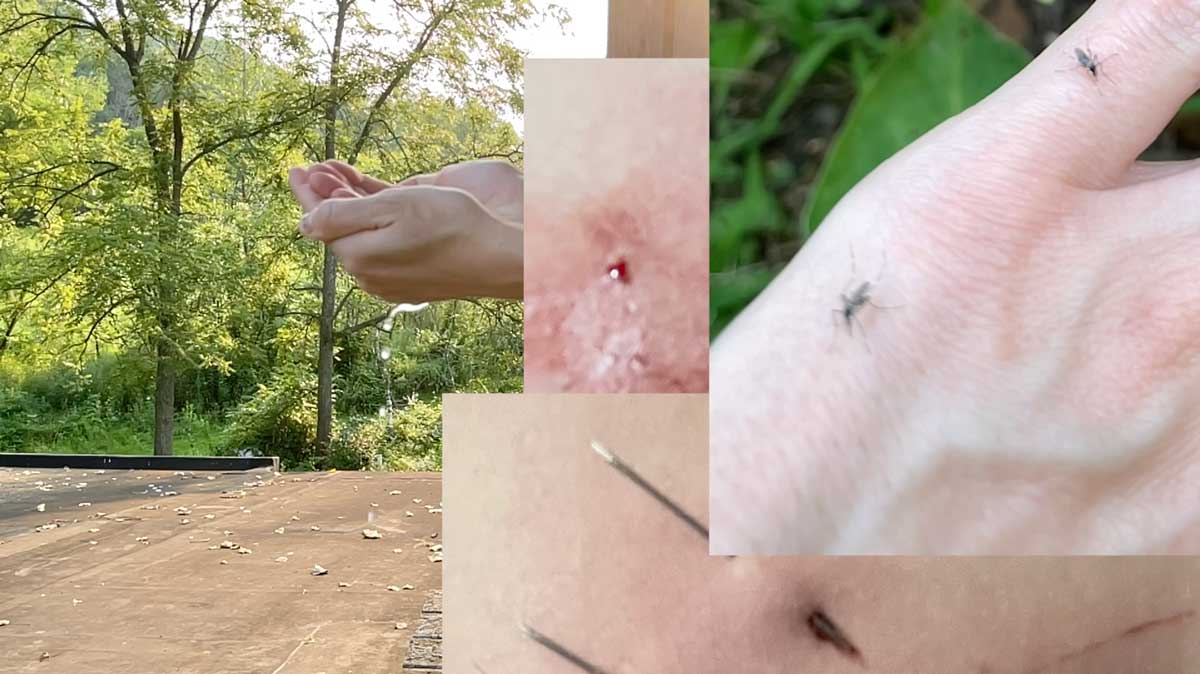
Let me sip a future beyond my blood (video still), Lindsey french
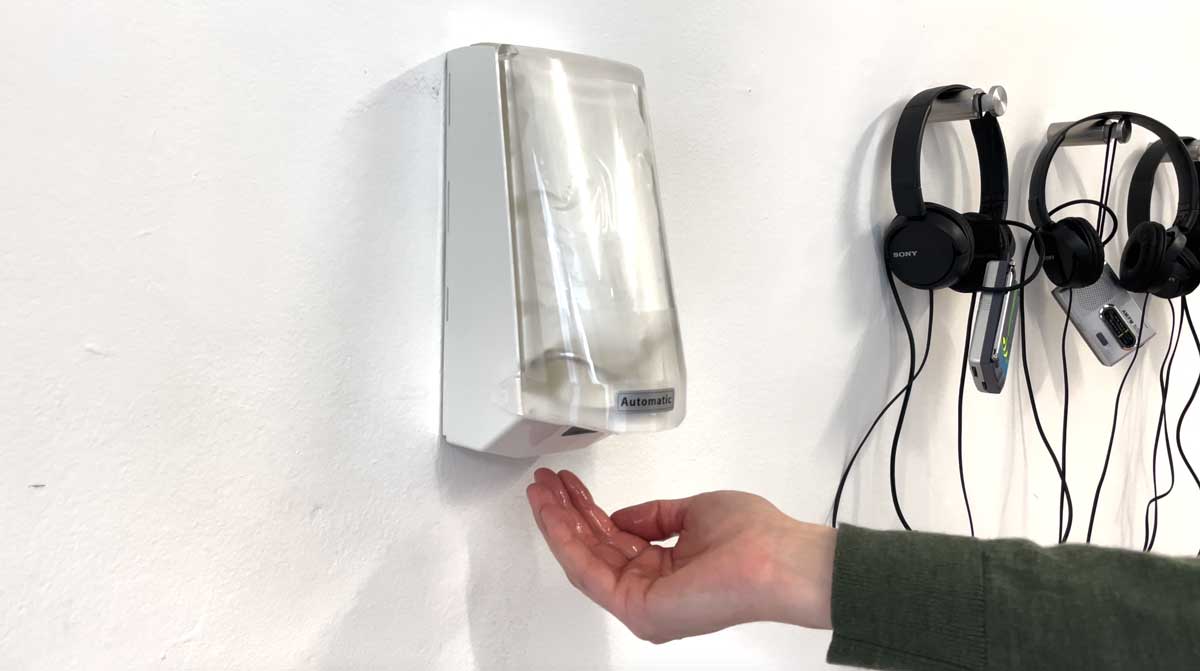
discreet broadcasts for Lisichiton americanus, Lindsey french
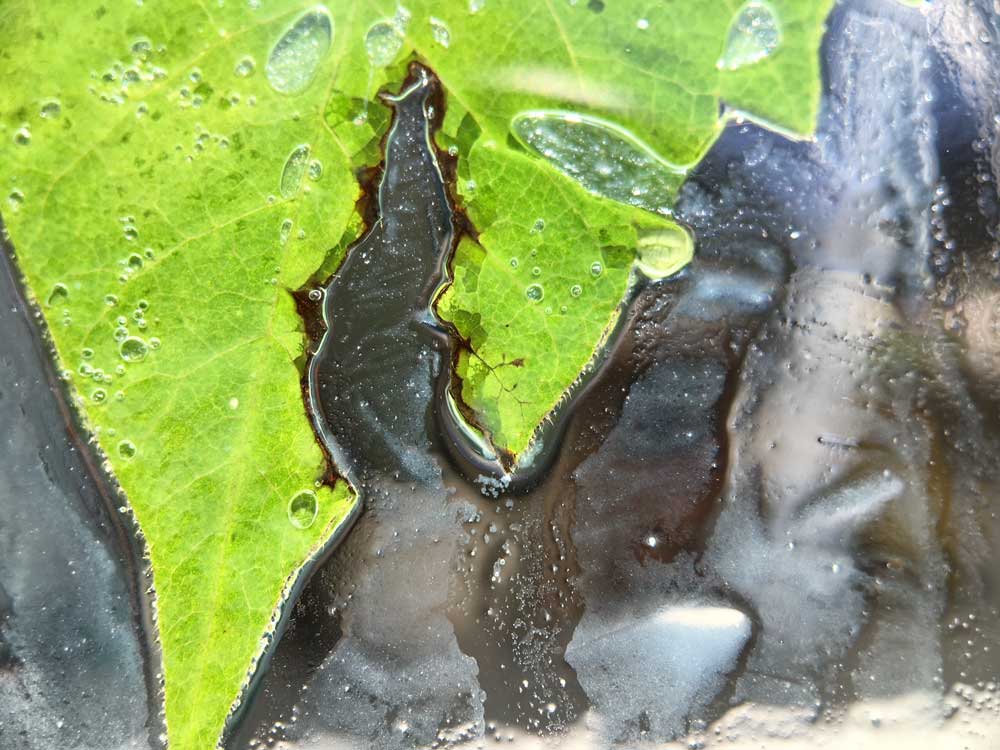
it takes time to process unintended harm, Lindsey french
Risk, Olfaction, and Multispecies Encounter
- Lindsey French, University of Regina
In an interview with Laverne Cox, feminist scholar bell hooks asks, “what does it mean for us to cultivate together a community that allows for risk – the risk of knowing someone outside your own boundaries?” Hsuan Hsu’s “The Smell of Risk” introduces the potential of olfactory art to confront us materially with the realities of environmental toxicity, which builds on Stacy Alaimo’s concept of “transcorporeality,” Alaimo’s way of describing porous entanglements with environmental agents. For this presentation, I propose an artist talk in which I share examples from a body of artwork which considers the role of risk through micro-encounters with often-maligned organisms who thrive under conditions of climate change and environments of human disturbance, such as poison ivy, mosquitos, and skunk cabbage. In “let me sip a future beyond my blood,” I create and apply a scented mosquito attractant to my skin as a ritual offering to female mosquitos, who feed primarily on nectar but require a blood meal for reproduction, while participating in the queer needling practice of erotic piercing. In “it takes time to process unintended harm,” I use the scent extraction method enfleurage to extract urushiol, the irritant in poison ivy, the same compound used for temporary “urushiol tattoos.” In “discreet broadcasts for Lisichiton americanus,” I create a hand sanitizer using the putrid scent of the western skunk cabbage. Through this work, I consider, what role does risk play in rethinking relationships, and developing practices to understand and destabilizing underlying social and political categories of power?
keywords: olfactory art, queer ecologies, multispecies exchange, risk
Lindsey french (she/they) is a settler artist, educator and writer whose work engages in multi-sensory signaling within ecological and technological systems. She has shared her work internationally in museums, galleries, screenings, and D.I.Y. art spaces including the Museum of Contemporary Art (Chicago) and the International Museum of Surgical Science (Chicago), Pratt Manhattan Gallery (New York), and SixtyEight Art Institute (Copenhagen). Publications include chapters for Ambiguous Territory (Actar, 2022), Olfactory Art and The Political in an Age of Resistance (Routledge, 2021), and Why Look at Plants. They earned a BA through an interdisciplinary course of study at Hampshire College, and an MFA in Art and Technology Studies at the School of the Art Institute of Chicago. Newly based in the prairie landscape of Treaty 4 territory in Regina, Saskatchewan, french teaches as an Assistant Professor in Creative Technologies in the Faculty of Media, Art, and Performance at the University of Regina.
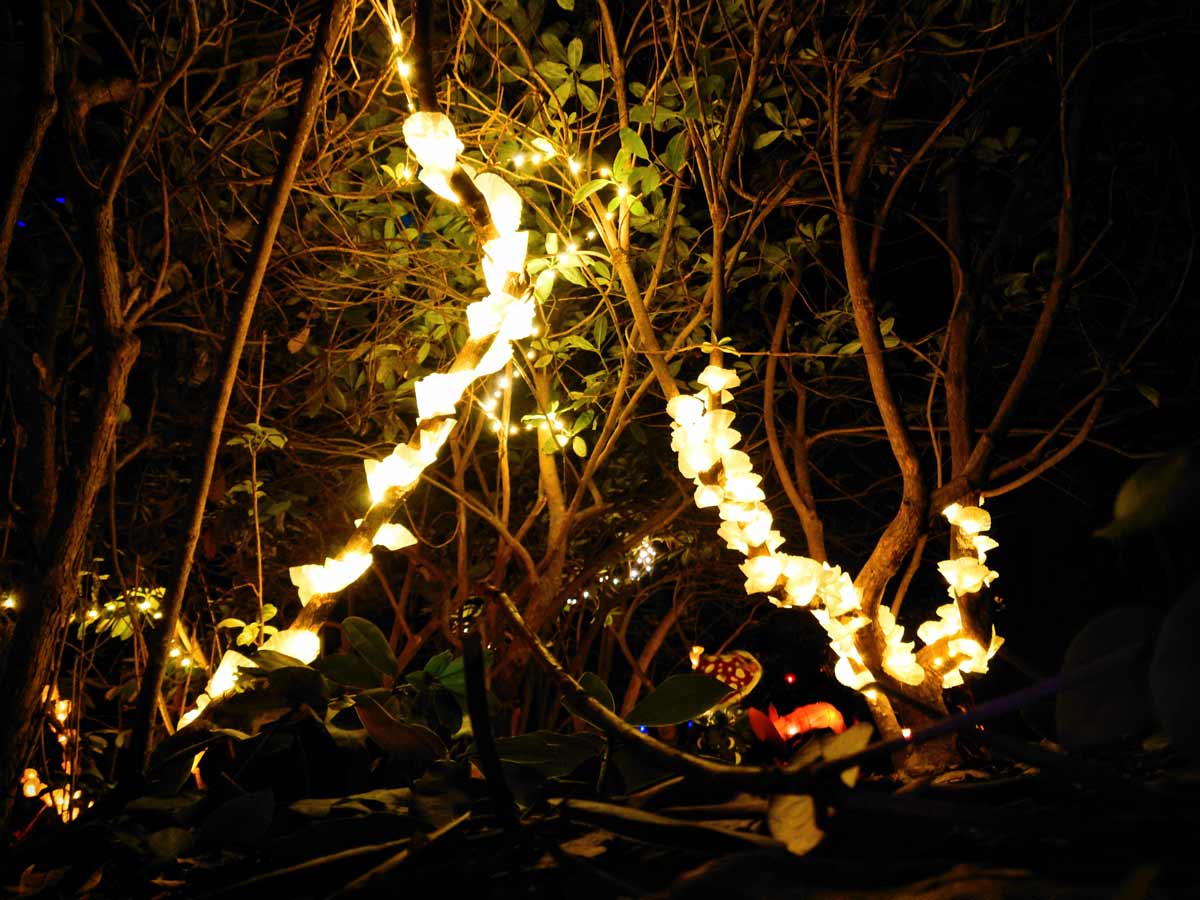
Mycelium Movement (Spore Drive), installation detail, Kathryn Wadel, LEDs, paper and Video Projection, dimensions vary, 2022.
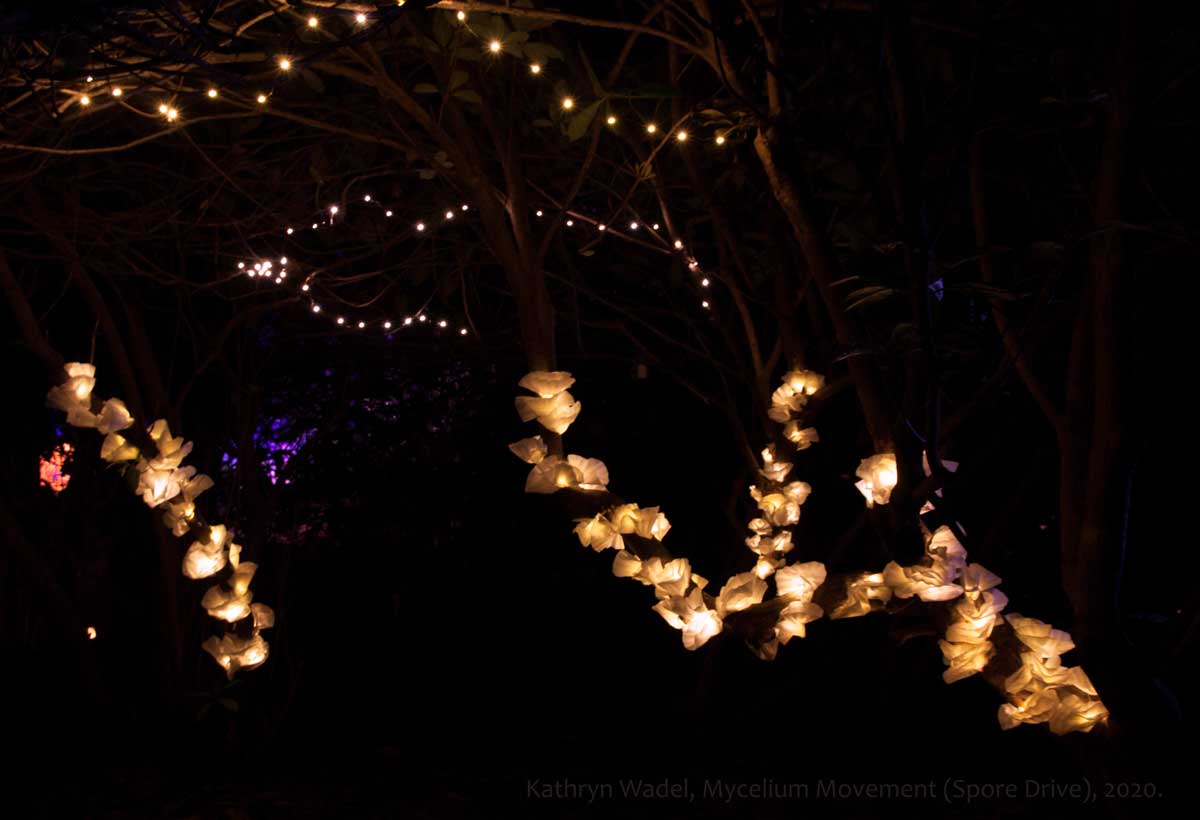
Mycelium Movement (Spore Drive), installation view, Kathryn Wadel, LEDs and paper, dimensions vary, 2020.
Mycelium Movement & Mother Trees
- Kathryn Wadel, artist, independent
Kathryn Wadel is an interdisciplinary artist and creator of the site-adaptable art installation, Mycelium Movement (Spore Drive), currently on view in the exhibition Symbiosis, at the Art Gallery of Greater Victoria (April 1 – October 29, 2023).
In this panel presentation Kathryn Wadel will review the materiality, iterations and allegorical thinking of their artwork as it relates to the symbiotic relationships between fungi and forests.
Mycelium Movement (Spore Drive) represents regrowth, renewal and the importance of fungi species for the sustainability of life on earth. The paper mushroom sculptures defuse soft, warm yellow lights, visualizing the complexly beautiful fruiting bodies and community connections fungi species share with forests.
Though mushrooms and fungi are often associated with death/decay, these creatures cultivate rich soil for new growth and nourish the cycle of life. They are the mass communicators of the forests and are integral to the sustainability of healthy and diverse ecosystems. On the microscopic level, mycelium interconnect with tree root systems, entire forests and ecosystems; their symbiotic relationship and intergenerational knowledge with mother trees span centuries. As part of a healthy ecosystem, the reciprocal relationship between mycelium and trees pass down generational knowledge and nutrients to younger or sick trees within their living network. Akin to our born and chosen families, they support each other through all stages of life and truly live stronger as a community.
keywords: mycelium, mother trees, installation, symbiosis, Spinoza, interconnection
Kathryn Wadel is second-generation Filipinx-Canadian settler living on the unceded and traditional territories of the Katzie First Nation and the Kwantlen First Nation. She has an interdisciplinary mixed media art practice and a BFA degree from Emily Carr University of Art + Design.
Kathryn explores environmental, cultural and social practices that connect communities across disciplines. She combines traditional with digital media in her exhibiting art practice and fosters community engagement to explore the human condition as it exists within the Anthropocene. Kathryn is an Artist in Residence with the Vancouver School Board in the Renfrew-Collingwood community (2021-2023) and has exhibited her art in: Symbiosis at The Art Gallery of Greater Victoria, The Renfrew Ravine Moon Festival, Quantum Futures at the Museum of Anthropology, Leaning Out of Windows at ECUAD, Invasive Systems at VIVO Media Arts and Art 4 Life at The Port Moody Art Gallery.
